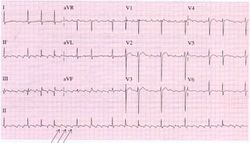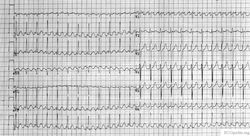Atrial Flutter: Difference between revisions
m New page: ===Atrial flutter=== {{Arrhythmias| | name = Atrial flutter | locatieImage = 250px | atrial_frequency = 250-350 bpm | ventricular_frequency = 75-150bpm... |
mNo edit summary |
||
| Line 1: | Line 1: | ||
{{Arrhythmias| | {{Arrhythmias| | ||
| name = Atrial flutter | | name = Atrial flutter | ||
| Line 12: | Line 11: | ||
| example2 = Atrial flutter with 2:1 conduction. [[Image:ECG_Aflutt.jpg|250px|Atrial flutter]] | | example2 = Atrial flutter with 2:1 conduction. [[Image:ECG_Aflutt.jpg|250px|Atrial flutter]] | ||
}} | }} | ||
During atrial flutter the atria depolarize in an organized circular movement. This is caused by [[Arrhythmias#Re-entry|re-entry]]. The atria contract typically at around 300 bpm, which results in a fast sequence of p-waves in a sawtooth pattern on the ECG. For most AV-nodes this is way to fast to be able to conduct the signal to the ventricles, so typically there is a 2:1, 3:1 or 4:1 block, resulting in a ventricular frequency of 150, 100 or 75 bpm respectively. Often the grade of block changes every couple of beats, resulting in e.g. 2:1, or 3:1 blocks and a somewhat irregular ventricular heart rate. The saw-tooth is especially prominent in lead II, this lead normally shows constant electrical activity: it is never horizontal. Causes and risk of atrial flutter are comparable to atrial fibrillation. | During atrial flutter the atria depolarize in an organized circular movement. This is caused by [[Arrhythmias#Re-entry|re-entry]]. The atria contract typically at around 300 bpm, which results in a fast sequence of p-waves in a sawtooth pattern on the ECG. For most AV-nodes this is way to fast to be able to conduct the signal to the ventricles, so typically there is a 2:1, 3:1 or 4:1 block, resulting in a ventricular frequency of 150, 100 or 75 bpm respectively. Often the grade of block changes every couple of beats, resulting in e.g. 2:1, or 3:1 blocks and a somewhat irregular ventricular heart rate. The saw-tooth is especially prominent in lead II, this lead normally shows constant electrical activity: it is never horizontal. Causes and risk of atrial flutter are comparable to atrial fibrillation. | ||
{{clr}} | {{clr}} | ||
[[Category:Supraventricular Rhythms]] | |||
Revision as of 19:18, 22 July 2007
During atrial flutter the atria depolarize in an organized circular movement. This is caused by re-entry. The atria contract typically at around 300 bpm, which results in a fast sequence of p-waves in a sawtooth pattern on the ECG. For most AV-nodes this is way to fast to be able to conduct the signal to the ventricles, so typically there is a 2:1, 3:1 or 4:1 block, resulting in a ventricular frequency of 150, 100 or 75 bpm respectively. Often the grade of block changes every couple of beats, resulting in e.g. 2:1, or 3:1 blocks and a somewhat irregular ventricular heart rate. The saw-tooth is especially prominent in lead II, this lead normally shows constant electrical activity: it is never horizontal. Causes and risk of atrial flutter are comparable to atrial fibrillation.

